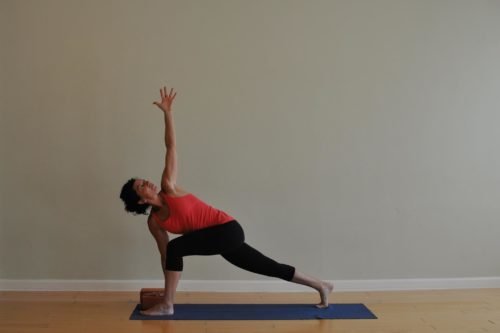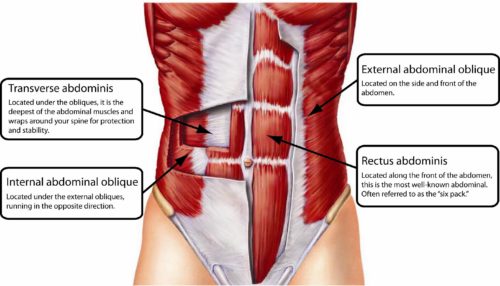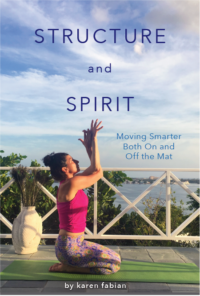
There are lots of movements we make in a one hour yoga practice. One of the significant benefits of yoga as a form of exercise is that it requires we move through all planes of the body. This isn’t always found in all kinds of exercise (think: running, cycling, rowing) and it’s not to say yoga is better than those kinds of exercise but it just bears noting. It’s always good to mix things up and even if another sport is your thing, working in a yoga practice or two a few times a week can be a great balance.
One of the actions we do in yoga that has a tremendous benefit to the spine in particular are rotational movements. When we twist, we not only strengthen the muscles that create this action, we also improve the health of the spine. Let’s first take a look at the muscular aspect of twisting.
The muscles
When we twist, the action is coming in part from a set of muscles called the obliques. You can see them in this image here:

When the obliques do their job by contracting, they help create the twisting motion of the torso. One of the added benefits of twisting is that it strengthens the core. Many people may think of crunches as the best way to build strength but that ignores the importance of these side stabilizing muscles. This is why twisting movements are a great strengthen for the entire core of the body.
Benefits to the spine
When we twist, the discs that reside between each vertebra are filled with fluid. As we move through our activities during the day, the fluid moves out of the discs to some degree. When we rest at night, the fluid returns. Fluid helps keep the discs plump and while aging can decrease that fluid to some degree, movement helps retain the fluidity of the discs, despite aging. The more fluid we have between the discs, the less possible compression on the spinal nerves and the better shock absorption we have. Think of the lumbar vertebrae, way down the back and all the weight above that they need to support; it’s essential that these vertebrae have healthy discs in between them.
Do twisting movements “detox” your organs?
You might wonder, after a yoga class, if you’ve “detox’ed” your body in some way. I know the feeling: you’re hot and sweaty and you feel “wrung out.” Of course you feel lighter and a bit “de-toxed” too! But what exactly happened? Well, I asked a friend and an expert on human physiology (among other things), Dr. Rachele Pojednic. She is an assistant professor of nutrition at Simmons College, a scientist at Beth Israel Deaconess Medical Center, a former research fellow at Harvard Medical School and has a PhD from the Tufts University Friedman School of Nutrition Science and Policy in biochemical and molecular nutrition and exercise physiology. For my latest book, “Structure and Spirit: Moving Smarter, Both On and Off the Mat,”  I asked her to speak to this reference: “Does twisting detox the organs?” Here is what she said:
Dr. Pojednic: The notion that twisting is a method of detoxification is quite a misrepresentation of what is actually happening to your organs while you are in poses like Twisting Crescent Lunge or Spinal Twists. You cannot “wring out” your kidney or liver like a sponge. These organs have a very specific integrated network of physical components and biochemistry that are responsible for making them work properly. In twisting positions, for the most part, your organs are simply being squished onto one side of your body or another. The one potential exception is your large intestine. The twisting motion in this case may serve to move digested food more efficiently throughout the intestinal network so that yo can have more regular and productive bowel movements. However, this is a result of physical manipulation, similar to running your hand over your abdomen. It is not chemically detoxifying your large intestine.”
Now, does this negate the “feeling good” feeling you might have after class? Of course not! But it just reveals that some of what we may have heard about the benefits of yoga might not be exactly spot on.
As teachers, we may be tempted to say things that might not be entirely true, just because we heard other teachers say them. I’ll admit in my early days, I said things that I heard and on some level, just believed them because I believed in the source. Yoga teaching is in part an art form and certainly, just like singing or sharing from the heart, sometimes we say things to inspire that have an artistic nuance to them. But for myself, over the past several years, I try to stay away from being a convincer of the benefits of yoga and simply let it stick up for itself.
Think back to some of the classes you have taught, if you are a yoga teacher. What might you have said in class that didn’t feel authentic to you? Why did you say it? Were you trying to impress the class? Did you have some ideas or thoughts from your own experience or did you feel you were repeating what others have said?
The process of becoming your own teacher starts with being authentic. Of course, as a new teacher, you’re depending on what you’re taught to be correct and valid. But this doesn’t mean you don’t ask questions, check things out, seek other ideas and lessons. It’s also an ongoing process and one that will be ever evolving.
Special offers for you
Love anatomy? Click here for my free 3-video training on anatomy. It’s short- only 3 videos of about 5 minutes each- but will cover some of the essentials when it comes to hips, backbends and shoulders. The link also contains a free anatomy download as well!
Want to learn more about twisting poses, other key anatomical principles as well as spiritual themes? That’s the focus on my book, “Structure and Spirit: Moving Smarter, Both On and Off the Mat.” The discussion about above twisting is part of a larger exploration into themes of yoga anatomy and the second half of the book explores spiritual themes as well. Learn more about the book and purchase it via Amazon by clicking here.Â

As always, thank you for reading and feel free to leave a comment!

Thank you so much for sharing this. I’m a scientist and I initially became interested in yoga teacher training because I was skeptical of claims made in classes, like twisting to detox; I wanted to find out what the heck that meant. I do think it’s important for teachers to constantly ask the “why” behind the pose and the intended benefit, as we don’t dive in too deep in teacher training. I look forward to sharing this post with my students!
Victoria, hello! I am so happy to meet you! We share a similar approach and I am honored that you found the post interesting. I can say that I share your love of science and presenting things from the perspective of the concrete. Although I love the spiritual side of yoga, I teach from the anatomical and that means not a lot of wishy washy yoga speak. I am glad you found the post interesting and hope that we have a chance to connect again soon. Thanks!